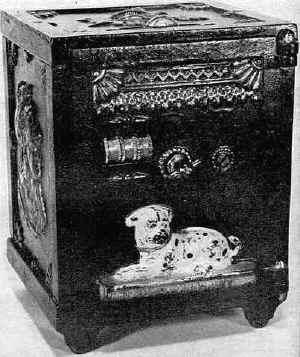Watch Dog Safe
by F.H. Griffith - HOBBIES Magazine - July, 1972
 A very limited number of mechanical banks were made in the form of
a safe. Quite the opposite is true in the case of the still banks. There are so many
different safe type still banks the exact number is not known, sufficient to say it runs
into hundreds of kinds. Since the inception of these articles, we have covered only four
safe type mechanicals in the 20 odd years. These are The United States Bank, Fortune
Teller Savings Bank, Magic Safe, and the special article on the Magic Safe (Nickels Only).
Now we come to the Watch Dog Safe, appropriately named, and No. 210 in the numerical
classification. If one chooses, this bank very nicely fits in with the dog group. It
certainly is a well conceived toy mechanical savings safe when we take into consideration
that the dog guards or watches the money therein and on the deposit of each coin
acknowledges same with a squeaking bark.
A very limited number of mechanical banks were made in the form of
a safe. Quite the opposite is true in the case of the still banks. There are so many
different safe type still banks the exact number is not known, sufficient to say it runs
into hundreds of kinds. Since the inception of these articles, we have covered only four
safe type mechanicals in the 20 odd years. These are The United States Bank, Fortune
Teller Savings Bank, Magic Safe, and the special article on the Magic Safe (Nickels Only).
Now we come to the Watch Dog Safe, appropriately named, and No. 210 in the numerical
classification. If one chooses, this bank very nicely fits in with the dog group. It
certainly is a well conceived toy mechanical savings safe when we take into consideration
that the dog guards or watches the money therein and on the deposit of each coin
acknowledges same with a squeaking bark.
The Watch Dog Safe was made in the 1880’s-1890’s period and it is attributed to the J. & E. Stevens Company. The writer had an interesting experience years ago on the occasion of one of his visits to the Stevens Company. Usually Saturday afternoon or a Sunday was the best time to look around the place since a person, with proper permission, could do so with less disturbance involved. In any case, while in one of the buildings that contained the pattern room, always kept locked, the writer was permitted to go in and look through this special room. On the back of the wooden door of the room he noticed a colored advertising card of the Watch Dog Safe which had been glued to the door many years before. Mr. Frisbie, the man in charge, was kind enough to permit the writer to carefully remove this card from the door. At the time Mr. Frisbie said they had made the bank at Stevens and the card in question was one of their advertising flyers pasted on the door by one of the workers. Interestingly enough, the writer has never seen a Stevens catalog picturing this bank, so the card is of considerable importance. It is in colors, accurately depicts the bank, and along with showing the name "Watch Dog Safe", it states "When Deposits are made the Watch Dog Barks."
The bank shown is in all original condition and the paint is rather good for this particular bank. For some reason the Watch Dog Safe is somewhat difficult to find in nice original paint condition. Colors are as follows: The overall safe is black and decorations on the door are in gold. The dog is white with black markings and he wears a red collar. The extended or protruding section under the dog is silver. The top of the bank shows a brown bird in a yellow nest on a brown tree branch with green leaves. This is cast in relief. Gold decorations are in each corner of the top. On each side of the bank, cast in relief, is a Roman or Greek type bust. This is in gold, and on top of the helmet-like headgear is a long tailed brown bird. Both sides also have gold decorations in each of the four corners. This completes the coloring of the bank.
To operate, a coin is placed in the provided slot in the top of the safe. The coin stays in place until the lever on the left side of the bank is pressed upward. In so doing the coin drops inside automatically and the dog on the front lowers his jaw opening his mouth. A barking sound is emitted by means of a bellows inside the bank. This bellows is depressed by means of mechanism in connection with the operating lever. On release, the lever and parts return automatically to their respective positions. The operating mechanism inside the bank is interesting and rather unique. It is made in such fashion that it disconnects itself when the door is opened since working parts are on the inside of the door, as well as inside the safe itself. These parts engage themselves when the door is closed.
Coins are removed from the bank by means of the combination lock on the door. This combination number is usually 217, although other combined numbers may have been used.
